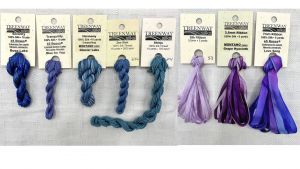
Above: understanding the information on Treenway Silks' threads and ribbons hang tags.
With over 1,150 different 100% silk thread and ribbon choices, it can be a bit overwhelming. Here's a simple overview of how the hang tag can help you make sense of everything.
We have five weights of silk threads and five silk ribbon widths.
The name of the thread or ribbon width is always just below the Treenway Silks logo. [see photo #2 & #3 below]
The threads names are:
Serenity: similar in size to a #3-#5 perle; reeled silk thread Click here for Serenity tips and tricks.
Tranquility: similar in size to a #8-#10 perle, with a textural tight twist; similar to Victorian Buttonhole Twist; reeled silk thread
Harmony: 6-strand silk floss; spun silk thread
Zen Shin: similar to size #8-#10 perle; spun silk thread
Shinju, our newest thread: similar to size #5 perle with a textural tight twist; spun silk thread Click here to read Shinju's introduction
The silk ribbon widths are:
2mm (natural white only)
3.5mm
7mm
13mm
26mm (natural white only)
We have three color lines that we dye our silk threads and ribbons:
Treenway Silks uses "colorway" (rather than "color") when referring to our hand-painted, multicolor (i.e. variegated) colors.
1) Treenway Silks hand-dyed solid colors:
These have the color number hand-written on the lower right corner of the hang-tag. There are 121 hand-dyed colors. [see photos below]
These colors numbers also have color names, which will appear on the website, but only the color number appears on the hang-tag. The color numbers are #1-#57, #201-#226, #301-#322, #951-#9517 (for the last set of color numbers, think "Ninety-five One, Ninety-five Two ... Ninety-five Ten ... Ninety-five Seventeen).
In addition to our 121 solid colors, we also have 18 limited edition Natural Dye colors. The Natural Dye colors say "natural dye" just above the hole holding the silk. The color numbers are between #1001 and #1023.
2) Montano hand-painted colorways:
This color line is named for Judith Baker Montano who collaborated with Treenway Silks about 16 years ago to develop these 74 colorways.
Montano colorways have a color name (no number). These will say "Montano color" right above the color name (which is always right above the hole that holds the silk). [see photos below]
3) 65 Roses hand-painted colorways:
This color line was begun in 2017 and the name was chosen because young children with cystic fibrosis often say "65 Roses" when saying the name of their disease.
Treenway Silks donates a minimum of 10% of all 65 Roses sales to Cystic Fibrosis Foundation, in honor of Andrea's angels. With your support, Treenway Silks has donated (life-to-date) $22,000 as of June 20, 2023.
65 Roses colorways have a color name (no color number). Usually the name is a variety of rose that inspired the colorway. [see photos below] When you click on "details", there will be a link to the rose that inspired the colorway.
65 Roses colorways may be perpetual or limited edition colors:
Perpetual colorways say "colorway for cystic fibrosis research" just above the color name (which is right above the hole holding the silk). [see photos below]
Limited Edition colorways will say "Limited Edition color for cystic fibrosis" just above the color name. [see photos below]
When we develop new 65 Roses perpetual colors, we strive to create colorways that are different from the Montano colorways. This means when the Montano colorways are arranged in color wheel order, the 65 Roses colors "fit in the gaps" between the Montano colorways. Our objective is to "add to" our color choices, rather than to have our color lines compete with each other.
DYE TERMONOLOGY:
Hand-painted, overdyed, hand-dyed…what does it all mean?
Hand-painted: the dyes are applied by hand to the natural-color silk, controlling exactly where each dye color is placed and how many inches of color—it’s like painting, but using dyes instead of paint. This is a labor-intensive process, requiring strong fingers to work the dye into the silk, patience and skill. Richard dyes all of our hand-painted silk threads, silk ribbons and silk combed top (used by spinners).
Overdyed: the natural-color silk is immersion-dyed one color (or left naturally white) and then a second color is applied to parts of the hank. This can be done several ways, such as a spray, or ‘dip dye’ part(s) of the hank, clamps to create resist, or manipulate the hank before additional immersion into the dye pot. Treenway Silks does not use overdye process.
Hand-dyed: the hank is immersion-dyed in a dye pot and produces one color. Depending upon the skill of the dyer and her desired outcome, the color can be uniform or ‘tonal’. At Treenway Silks, we strive for consistent, uniform color.
We are truly hand-dyers on a small scale, dyeing no more than five hanks in one dye pot. Dyeing silk consistently requires not only precise measurements, but also extremely consistent procedures to consistently reproduce the colors time and time again. Susan does all Treenway Silks' immersion dyeing.
Natural-Dye Colors (limited editions)
All Treenway Silks’ natural-dye colors were hand-dyed in Colorado with natural dye extracts derived from plants, roots, barks, berries and insects. The natural dyes used are from responsible, sustainable sources that are organic and fair traded. The dye recipes, formulated exclusively for Treenway Silks, use only safe, non-toxic, earth-friendly mordants and procedures that yield good-to-excellent wash and light-fastness.







